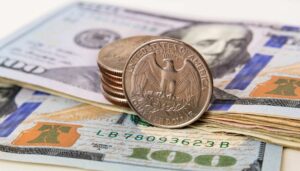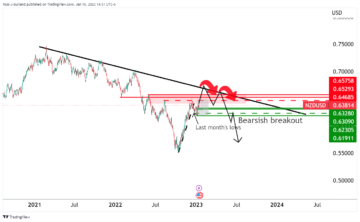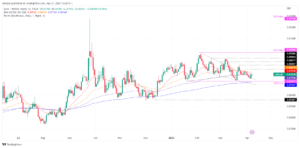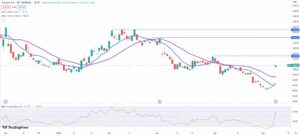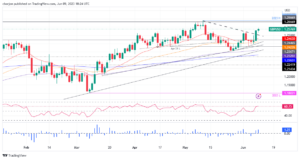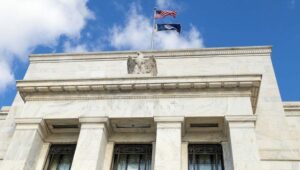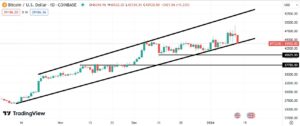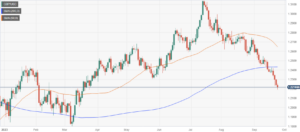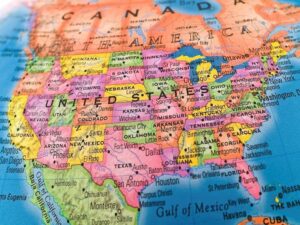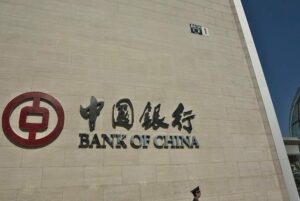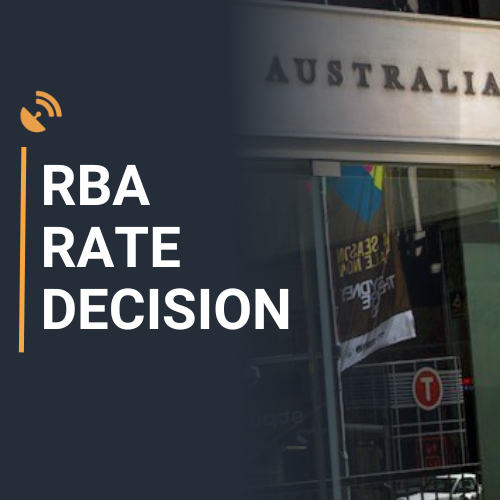
- Interest rate in Australia is likely to stay on hold at 4.35% in December after November’s hike.
- Reserve Bank of Australia Governor Michele Bullock could leave the door ajar for more tightening.
- The Australian Dollar is set to rock on any surprise in the language of the RBA’s policy statement.
The Reserve Bank of Australia (RBA) is set to pause its tightening cycle once again, leaving the Official Cash Rate (OCR) unchanged at a 12-year high of 4.35% following the conclusion of its December monetary policy meeting on Tuesday. The decision will be announced at 03:30 GMT.
As markets widely expect the RBA to keep interest rates unchanged, all eyes will remain on Governor Michele Bullock’s forward guidance in the policy statement for a fresh directional impetus on the Australian Dollar.
Reserve Bank of Australia to stand pat as inflation resurgence wanes
Amidst a resurgence of inflationary pressures, the Reserve Bank of Australia raised the benchmark interest rate by 25 basis points (bps) from 4.10% to 4.35% in November after keeping it on hold for four straight meetings.
Since then, Australia’s inflation and retail spending have cooled down, cementing the case for the central bank to keep its cash rate unchanged this week. Data from the Australian Bureau of Statistics (ABS) on Wednesday showed its monthly Consumer Price Index (CPI) climbed at an annual pace of 4.9% in October, slowing from the previous increase of 5.6% and below expectations of a 5.2% acceleration. The RBA’s closely-watched measure of core inflation, the trimmed mean, rose an annual 5.3% in October, easing from 5.4% the previous month.
The services inflation, measured by the Wage Price Index, rose 4.0% annually, at the fastest pace since early 2009. The uptick in pay growth was largely priced in by the RBA, as it hiked rates last month. Further, markets believe the surge in wage inflation is caused by one-off factors and is unlikely to be recurrent.
Meanwhile, Australian Retail Sales dropped 0.2% in October on a monthly basis, missing expectations for growth of 0.2% while reversing a 0.9% jump seen in September. Weakening economic indicators justify the expected pause in the central bank’s rate hike cycle.
The main attention, however, is likely to be on the language in the policy statement, especially after the RBA guidance in November was perceived as dovish after Governor Bullock said in the statement, "whether further tightening of monetary policy is required to ensure that inflation returns to target in a reasonable timeframe will depend upon the data and the evolving assessment of risks." The October policy statement cited, “some further tightening of monetary policy may be required.”
The RBA will likely maintain its cautious tone, awaiting the fourth-quarter inflation report in January to decide on the next interest rate move for its first meeting of 2024 in February. Speaking at the Hong Kong Monetary Authority and Bank for International Settlements High-Level Conference last Tuesday, RBA Governor Bullock said, “the central bank has to be a ‘little bit careful’ with using rates to bring down inflation without lifting unemployment.”
Previewing the RBA policy decision, analysts at TD Securities (TDS) explained, “data has been mixed recently, with a red-hot labor market print but a sizeable retreat in CPI inflation and slowing retail sales. Thus, the RBA may take a cautious approach and keep rates on hold until Feb to reassess after it gets new staff forecasts and the Q4 CPI. We expect little change to the MPS but a hawkish tint may not be surprising after Bullock's recent remarks.”
How will the RBA interest rate decision impact AUD/USD?
The Australian Dollar’s (AUD) fate hinges on the RBA’s communication on the path forward on the interest rate. Should Governor Bullock explicitly mention that more rate hikes remain on the table, AUD/USD is likely to extend its ongoing uptrend. On the contrary, a dovish pause by the RBA could trigger a meaningful correction in the Aussie pair toward 0.6550.
Dhwani Mehta, Asian Session Lead Analyst at FXStreet, notes key technicals to trade AUD/USD on the policy outcome. “AUD/USD has stalled its recent upbeat momentum just shy of the 0.6700 level, the highest level in four months. The 14-day Relative Strength Index (RSI), however, remains well above the midline while flirting with the overbought territory, suggesting that there is room for more upside in the Aussie pair.”
“Aussie buyers need acceptance above the July 31 high of 0.6740 on a daily closing basis to unleash further upside toward the 0.6800 round figure. The next upside barrier is seen around the 0.6850 region. On the downside, strong support is envisioned at Friday’s low of 0.6600, below which a test of the 200-day Simple Moving Average (SMA) at 0.6580 will be on the cards. The last line of defense for buyers is seen at 0.6550.”
Economic Indicator
Australia RBA Rate Statement
Decisions regarding this interest rate are made by the Reserve Bank Board, and are explained in a media release which announces the decision at 2.30 pm after each Board meeting.
Read more.- SEO Powered Content & PR Distribution. Get Amplified Today.
- PlatoData.Network Vertical Generative Ai. Empower Yourself. Access Here.
- PlatoAiStream. Web3 Intelligence. Knowledge Amplified. Access Here.
- PlatoESG. Carbon, CleanTech, Energy, Environment, Solar, Waste Management. Access Here.
- PlatoHealth. Biotech and Clinical Trials Intelligence. Access Here.
- Source: https://www.fxstreet.com/news/australia-interest-rate-decision-preview-rba-expected-to-stand-pat-on-lower-inflation-weakening-economy-202312041800
- :has
- :is
- :not
- 1
- 10
- 11
- 12
- 125
- 13
- 14
- 16
- 17
- 2%
- 2024
- 24
- 25
- 28
- 29
- 30
- 31
- 32
- 33
- 35%
- 67
- 7
- 75
- 8
- 84
- 9
- a
- above
- ABS
- acceleration
- acceptance
- After
- again
- All
- an
- analyst
- Analysts
- and
- announced
- Announces
- annual
- Annually
- any
- approach
- ARE
- around
- AS
- asian
- assessment
- At
- attention
- AUD
- AUD/USD
- aussie
- Australia
- Australian
- Australian dollar
- Australian Retail Sales
- authority
- average
- awaiting
- Bank
- Bank for International Settlements
- barrier
- basis
- BE
- been
- believe
- below
- Benchmark
- benchmark interest rate
- bias
- Bit
- board
- bring
- Bureau
- but
- buyers
- by
- Cards
- case
- Cash
- caused
- cautious
- cementing
- central
- Central Bank
- change
- cited
- Climbed
- closing
- Communication
- conclusion
- Conference
- consumer
- consumer price index
- content
- contrary
- Core
- core inflation
- could
- CPI
- cycle
- daily
- data
- December
- decide
- decision
- Defense
- depend
- Dollar
- Door
- Dovish
- down
- downside
- dropped
- each
- Early
- easing
- Economic
- economic indicators
- ends
- ensure
- envisioned
- especially
- Ether (ETH)
- Event
- evolving
- expect
- expectations
- expected
- explained
- explicitly
- extend
- Eyes
- factors
- false
- far
- fastest
- fate
- Feb
- February
- Figure
- First
- following
- For
- forecasts
- Forward
- four
- fresh
- from
- further
- GMT
- Governor
- Growth
- guidance
- Have
- Hawkish
- High
- high-level
- highest
- Hike
- Hikes
- hinges
- hold
- Hong
- Hong Kong
- Hong Kong Monetary Authority
- However
- http
- HTTPS
- Impact
- in
- Increase
- index
- Indicator
- Indicators
- inflation
- Inflationary
- Inflationary pressures
- interest
- INTEREST RATE
- Interest Rates
- International
- international settlements
- IT
- ITS
- January
- July
- jump
- just
- Keep
- keeping
- Key
- Kong
- labor
- labor market
- language
- largely
- Last
- lead
- Leave
- leaving
- Level
- lifting
- likely
- Line
- little
- Low
- made
- Main
- maintain
- Market
- Markets
- May..
- mean
- meaningful
- measure
- measured
- Media
- meeting
- meetings
- mention
- missing
- mixed
- module
- Momentum
- Monetary
- monetary authority
- Monetary Policy
- Month
- monthly
- months
- more
- move
- moving
- moving average
- mps
- Need
- New
- next
- None
- Notes
- November
- OCR
- october
- of
- official
- on
- once
- ongoing
- Outcome
- Pace
- pair
- path
- pause
- Pay
- perceived
- plato
- Plato Data Intelligence
- PlatoData
- pm
- points
- policy
- previous
- price
- raised
- Rate
- Rate Hike
- rate hikes
- Rates
- RBA
- RBA rate
- Read
- reasonable
- recent
- recently
- recurrent
- regarding
- region
- related
- relative
- relative strength index
- Relative Strength Index (RSI)
- release
- remain
- remains
- report
- required
- Reserve
- reserve bank
- reserve bank of australia
- Reserve Bank of Australia (RBA)
- retail
- Retail Sales
- Retreat
- returns
- risks
- Rock
- Room
- ROSE
- round
- rsi
- s
- Said
- sales
- Securities
- seen
- September
- Services
- session
- set
- Settlements
- should
- showed
- Simple
- since
- Slowing
- SMA
- speaking
- Spending
- Staff
- stand
- starts
- Statement
- statistics
- stay
- straight
- strength
- strong
- support
- surge
- surprise
- surprising
- table
- Take
- Target
- TD
- TD Securities
- territory
- test
- that
- The
- then
- There.
- this
- this week
- Thus
- tightening
- timeframe
- to
- TONE
- toward
- trade
- trigger
- true
- Tuesday
- unemployment
- unleash
- unlikely
- until
- upbeat
- upon
- Upside
- uptrend
- using
- wage
- was
- we
- Wednesday
- week
- WELL
- whether
- which
- while
- widely
- will
- with
- without
- zephyrnet

